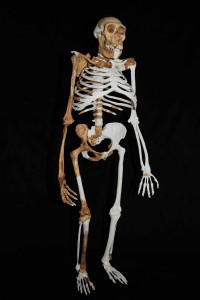Fossils show ‘weird’ mosaic of chimp-human traits

This undated image provided by Lee R. Berger and the University of the Witwatersrand shows a composite reconstruction of the skeleton of Australopithecus sediba. The newly studied species lived some 2 million years ago, and it both climbed in trees and walked upright. Scientists are getting a more comprehensive look at the extinct South African creature with an intriguing mix of human-like and primitive traits, but scientists say they still haven’t pinned down where it fits on our evolutionary family tree. Results were published in the journal Science on Thursday, April 11, 2013. AP PHOTO/UNIVERSITY OF THE WITWATERSRAND, LEE R. BERGER
WASHINGTON—She walked with a knock-kneed gait, with a heel like a chimp but the upright posture of a human, and she may provide the most complete evidence yet of early man’s closest ancestor, scientists said Thursday.
Two-million-year-old Australopithecus sediba’s awkward strut would eventually send a modern man begging for a knee or hip replacement, but scientists are stunned at how evolution equipped her for both climbing trees and walking.
The latest research on an unprecedented set of fossil bones from South Africa reveal an ancient creature with long arms and primitive shoulders like an ape, but legs that could straighten, dexterous hands and a human-like thumb for precision grip.
“Just a weird, weird combination,” said Jeremy DeSilva of Boston University, lead author of one of the six articles in the US journal Science that describe the most complete set of bones ever found for an early hominid.
The latest findings offer more distinctions from the famed hominid Lucy, who was discovered in 1974 and whose species Australopithecus afarensis roamed eastern Africa 3.2 million years ago, experts said.
“What these papers suggest is that sediba probably doesn’t come from the East African species that Lucy comes from,” said Lee Berger, who in 2008 discovered the fossil site of Malapa, north of Johannesburg, where excavations are ongoing.
Au. sediba walked in a way never before seen by researchers, with a rib cage and spine that is “very ape-like at the top and human-like at the bottom,” said Berger, a professor at the University of the Witwatersrand.
The bones of five individuals have provided some stunning firsts—the first-ever kneecap, the most well-preserved upper limb, and a complete set of foot, leg and hip pieces from an adult female that have allowed her gait to be decoded.
DeSilva said the adult female Au. sediba was a hyper-pronator, meaning her foot was tilted inward.
Without a strong heel base like humans have, she would have landed on the outside of her foot, causing her shin, knee and thigh bones to twist inwards and she strode.
Sound painful? To us, it might be. But maybe not to this female, referred to by researchers as MH2.
“They have the anatomy that allows them to do this and to do it well,” DeSilva told AFP.
The kneecap has a large ridge that keeps it in place, and likely kept MH2 and her cohorts alive in a dangerous world, he said.
Experts believe the creatures are so well-preserved because they died after falling into a sinkhole. So far they have uncovered remains of an adult female, a juvenile male, a toddler, an infant and another adult.
“This could very well be a family group,” said DeSilva. “I have never seen fossils this well preserved. It’s unreal. They are stunning.”
Articles detailing Au. sediba’s hands and teeth—signaling they ate a diet of fruit, leaves and bark—have been previously published.
Other studies in the current issue of Science offer a more detailed glimpse at their jaws, teeth, rib cage, upper arms and spine.
The work is part of an ongoing project by international scientists from the Evolutionary Studies Institute at the University of the Witwatersrand and 15 other global institutions.
“We have this incredibly exciting look, maybe the best look at any early hominid species that had ever happened,” said Berger.
“It may be that it should be considered the best candidate ancestor for early members of the genus homo.”
Zeresenay Alemseged, head of the anthropology department at the California Academy of Sciences, described the work as a “fantastic discovery.”
“What this really tells us is that early hominin evolution was more diverse at this time than we thought.”
However, he questioned the claim that this may be the closest ancestor of modern man, noting that other fossils have shown clues of the genus homo long before Au. sediba’s time, 2.33 million years ago.
“The link to homo is not well established. The torso, the clavicle, the foot have many primitive characteristics,” he added.—Kerry Sheridan